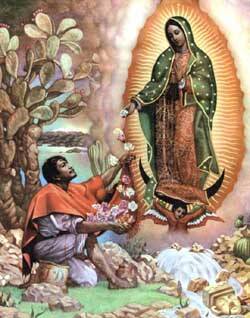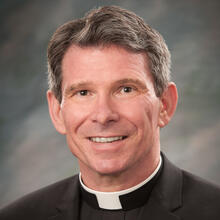In June 1531, the Bishop-designate of Mexico City, Fray Juan de Zumárraga, proudly reported to his Spanish superior in the Franciscan Order that he had destroyed “five hundred temples of their gods and more than twenty thousand images of the demons that they adored…” “They” were the subjugated Aztec people, only ten years under Spanish rule.
Modern missionaries do not take his approach, but, if one envisions evangelization as extermination, Juan de Zumárraga knew how to do it effectively. A temple is sacred spot, a home on earth where the divine dwells among us. Tearing down temples is a way of tearing out religion at its root. This was especially true for the warlike Aztecs, who, as José Luis Guerrero writes,
believed that through warfare they collaborated with their supreme deity, supplying human blood and hearts to maintain the harmony of the universe. The idea that the universe could go on as before even though war had ended stripped the Aztecs of their very reason for existence and made them question the validity of everything they had previously done and believed (Our Lady of Guadalupe, 2008).
A temple was a lifeline between deities and their denizens, one through which communion and blessing flowed. This is crucial in comprehending the meaning of the message that Juan Diego, a member of Zumárraga’s flock, received on a December morning, six months after the bishop’s report to Spain.
Attracted by the singing of birds, and then called by name, Juan climbed a hill, also a place where the divine touches earth. Then the chronicle says:
Arriving at the top of the hill, he was delighted to see a young woman, who out of love for him was standing, graciously inviting him to come closer. And when he arrived in her delightful presence he marveled at how her wondrous majesty surpassed all praises: Her garments shone like the sun, and the very rock upon which she stood seemed to emit beams of light. Her aura was as of a precious jewel, like jade, and the very earth seemed to ripple in splendor, shining like a rainbow in the mist. And the plants seemed like emeralds, their leaves the finest turquoise, their trunks, branches and thorns sparkling like gold.
For an Aztec, the description of the Lady is rich in meaning, but what is astounding, for a Christian, was her request. She tells Juan that “I greatly desire that my beloved sacred house should be built here, in order to show Him to you all, to exalt Him, to present Him to the peoples, He who is all my love, He who is my compassionate gaze, He who is my help, he who is my salvation.”
A pattern that is intrinsic to the gospels plays out here, one that helps to ascertain the truth of the apparition. It’s the paradox of the transcendent appearing in the commonplace, even the scorned. Here, as in the resurrection accounts, a woman gives testimony to the Christ. This wasn’t any more expected by Bishop Zumárraga than it was by apostles.
The woman asks that a new type of temple be built, one whose sacrifices will be unbloody yet efficacious. She effectively calls a people into a new home. Those who had lost a place of divine communion find it anew, but this temple will be more than mortar. It will be spiritual because it is personal. Indeed it is her very person. “God’s temple in heaven was opened, and the ark of his covenant could be seen in the temple” (Rev 11:19). The Virgin of Nazareth becomes the woman clothed with the Sun, the one from whom salvation dawns. And Juan can exclaim, as Elizabeth did before him, as the Church of the Americas does after him.
Most blessed are you among women,
and blessed is the fruit of your womb.
And how does this happen to me,
that the mother of my Lord should come to me? (Lk 1: 42-43).
Zechariah 2: 14-17 Luke 1: 39-47








